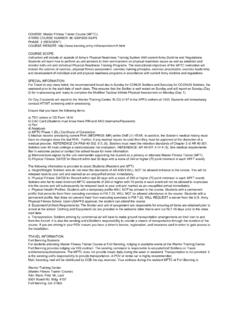Transcription of Enclosure Design Information Pack - Colchester Zoo
1 Enclosure Design Information Pack This pack is aimed for people who require in depth Information for course work and also for teachers to aid in their visit to Colchester Zoo. Contents Contents Page History of Keeping Animals 1 History of Enclosure Design 2 Zoos in the 21st Century 4 Laws and Considerations 5 The Animals Natural History 6 The Animals Needs 7 Staff Needs 9 Visitor Needs 10 Types of Barriers 11 Enclosure Size 14 Mixed Species Enclosures 15 Filter Systems 16 Points to Remember 17 Enclosure Design : Patagonian Sealion 18 Enclosure Design : African Elephant 19 Enclosure Design : Amur Tiger 20 Enclosure Design : Orangutan 21 Enclosure Design : Komodo Dragons 22 Enclosure Design : Lorikeets 23 Enclosure Design : Humboldt Penguins 24 1 As understanding of animals increases and technology advances, the way animals are housed in zoos has changed and will continue to change.
2 Public attitudes can also affect how animals are housed. What was considered acceptable 20 years ago, may not be accepted now. New laws and regulations further impact on how the animals are housed and managed. Animals have been kept in captivity for thousands of years for a number of reasons. History of Keeping Animals In ancient Egypt, animals were a sign of power and wealth, as seen in these paintings. In ancient Rome, animals were used to fight each other or gladiators for entertainment From the 13th century, the royal collection was kept at the Tower of London where people could pay to see the animals. In the 1800 s, zoos were places of scientific interest and were more like living museums. 2 History of Enclosure Design People s attitudes towards animals and nature has changed since the early days of zoos.
3 Before, the welfare of the animal wasn't a factor in the Design of the Enclosure and what was considered the acceptable way to keep animals is very different to what is deemed acceptable today. The three pictures below show some examples of how Enclosure Design has changed. With a better understanding of animal welfare and the natural world, combined with improvements in technology, enclosures now are very different to how they were and now emphasis is on more natural looking, realistic designs rather than a stylised look. Animals were kept in a manner that displayed them on show at all times and kept in single species enclosures. Seen more as curiosities rather than living things. In 1907, the use of moats and hidden barriers were used at Hamburg Zoo in Germany. This showed animals in a more natural looking environment and showed multiple species in the same area.
4 The first Enclosure to do this can been seen in the picture and was so successful, it is still used today. Enclosures are now becoming more about the whole habitat rather than just about the animal. Some zoos are creating ecosystems with real plants and multiple species of animals. The visitors are often able to use walkways to be in the Enclosure . This is called immersion Design 3 Then and Now Peter Jennings The penguin Enclosure late 1970 s The penguin Enclosure late 2015 Sheelagh Marron-Boris The lion Enclosure early 1960 s The lion Enclosure mid 2010 s Richard Martin The white rhino Enclosure late 1980 s The white rhino Enclosure late 2000 s The following pictures show examples of how Enclosure Design has changed. The pictures on the left show how some of the enclosures looked at Colchester Zoo and the pictures on the right show the enclosures now.
5 4 Zoos in the 21st Century In the 21st century, zoos fulfil four main roles: Research Conservation Education Recreation Better understanding of animal behaviour and welfare, combined with zoos focusing on international breeding programmes and education, have all impacted on how zoos Design enclosures. Many zoos are members of national, regional and international zoo associations, all of whom have their own criteria for how animals should be housed and looked after. Colchester Zoo is part of three associations: BIAZA Theand Irish Association of Zoos and Aquariaa conservation, education and scientific wildlife charity, ensuring the principles and practices of animal management. EAZA The European Association of Zoos and Aquaria is a conservation, education and scientific wildlife association who coordinate breeding programmes within European zoos.
6 Every continent have their own equivalent of EAZA. WAZA The World Association of Zoos and Aquaria provide leadership and support for zoos, aquariums, and associations of the world in animal care and welfare, conservation of biodiversity, environmental education and global sustainability. 5 Laws and Considerations Zoos in the are also subject to and European Laws. The EU Zoo Directive and Zoo Licensing Act 1981 state that zoos must: Accommodate their animals under conditions which aim to satisfy the biological and conservation requirements of the species to which they belong The Animal Welfare Act 2006: The Welfare Act 2006owners and keepers responsible for ensuring that the welfare needs of their animals are met. These include the need: for a suitable environment (place to live) for a suitable diet to exhibit normal behaviour patterns to be housed with, or apart from, other animals (if applicable) to be protected from pain, injury, suffering and disease When designing a new Enclosure there are several factors that needs to be part of the process, along with the aforementioned laws and regulations.
7 One key part to remember is there are three groups to consider when it comes to designing enclosures. The animal The staff The visitor Zoos have to find a balance between all three to ensure the animal has good welfare, the keeper can work safely and that visitors can see the animal, which they have paid to see. When designing an Enclosure , there are several factors that need to be considered. What type of animal is it? How many animals the Enclosure is going to house? Physical health Mental health General maintenance Education Safety Veterinary Care On a basic level an Enclosure should allow the animal to express as many natural behaviours as possible, allow the animal to feel safe and provide education to the visitors. 6 The Animals Natural History Mangabey Enclosure Squirrel monkey outside Enclosure The term natural history refers to the behaviour of the animal, the animal s natural habitat and the adaptations they have.
8 For example, a Patagonian sealion comes from the cold seas off the coast of South America. The seas are cold due to the Humboldt current that comes directly from the seas around Antarctica. They live in groups and spend most of their time in the water. They have thick waterproof fur and a layer of blubber under the skin to help them keep warm. When designing an Enclosure for these sealions, the Enclosure must allow them to swim as they spend most of their time in the water and allow more than one individual to live in the Enclosure as they live in groups. The water should not be heated as they are adapted to the cold sea, and if the water was warm they would overheat. They will also spend time on land to rest so there should also be a beach area. For animals that are arboreal (tree dwelling) it is important that they are given the opportunity to climb.
9 This can be done by having actual trees and plants in the Enclosure and/or climbing frames and ropes. Climbing frames are useful and allow for complex designs, however, they are solid structures and this can make the climbing too easy for the arboreal animal. The use of ropes will make a climbing frame much more interesting and make climbing a bit harder and thus better for exercise. 7 The Animals Needs The physical and mental health of the animal must be maintained. This can be done in a variety of ways. One way is making sure the Enclosure is suited to the animals by looking at the animals natural history as mentioned on the previous page. Animals that burrow and dig should be able to do so, for example. The correct temperature should also be maintained especially for reptiles and species that come from tropical regions.
10 It should also be remembered that animals that come from cold regions are given methods to stay cool and not overheat; this can be done by not having any heating in the Enclosure , for example the Amur tiger copes with temperatures of 40 degrees C in the wild so they will often spend most of the day outside during winter and prefer to sleep in the snow. In addition, providing pools to cool off or having a sprinkler system can help animals get more comfortable in very hot weather. Heated rocks and heat lamps can be used for animals that prefer some warm rather than a constant warm temperature. The correct social grouping is important. Having a solitary animal in a large group will have a negative impact on the animal and having a social animal on their own will do the same. Regardless of how sociable an animal is, it is important that retreats are available to allow privacy from certain members of the group, but also from visitors.





